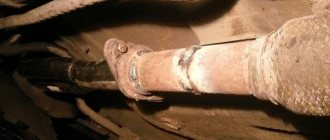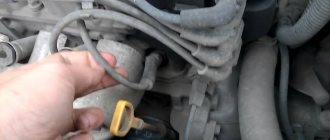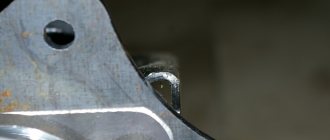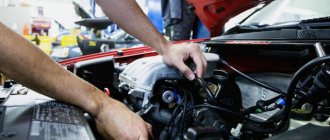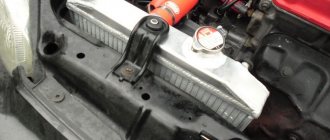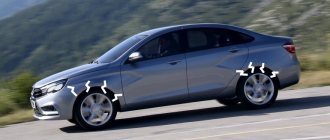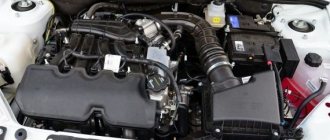Specific hum conditions
This article focuses on the causes of brake buzzing after loads.
It is also worth noting that this article will discuss the possible causes of only one specific type of brake hum. Namely, when it manifests itself exclusively after intense driving. This can be a long drive in city mode, where acceleration and braking alternate one after another. This also includes a hum that occurs after a few moments of pressing the pedal when driving at a respectable speed.
Any other noises - rattling, whistling, grinding, clanking - even if it is possible to “cure” after reading this material, then this should be perceived as random luck. The article is also not about vibration of the brake pedal and beating of the steering wheel. By the way, all of the above is much easier to diagnose than when a hum when the brake is pressed occurs precisely under load. We will try to solve this specific problem further.
Other noises
In addition to the hum, you can hear other sounds in the cabin. The most disgusting phenomenon can be called vibration. Most often, it occurs when the engine mounting mounts have become loose. In this case, when the engine is idling, this phenomenon will only intensify. The problem is solved quite simply. You need to tighten the nuts securing the power unit, and the vibration will go away.
A sharp squealing sound coming from under the hood, which intensifies during acceleration, indicates the need to tighten or replace the alternator drive belt. First you need to assess its condition visually; if there is no damage on it, you should tighten it. Sometimes, this is enough. But, in the case when the squealing still does not stop, replace it with a new one. Experienced drivers always carry a spare alternator belt with them in case it breaks.
It is also unpleasant to hear squeaking plastic in the car. In common parlance, such sounds are called crickets. Mainly owners of budget cars suffer from this misfortune. There are no universal recipes for eliminating this problem. In each case, you need to understand it individually and find your own solutions.
Conclusion
. Noise in a car is quite an unpleasant phenomenon. This gets on the nerves especially strongly when traveling long distances, when the driver is forced to drive for a long time. Therefore, many are interested in why there is a hum in the car interior when driving. After all, knowing the cause of the noise, you can eliminate it quite quickly. Which is important in this case, because most of the noise is caused by dangerous malfunctions.
All possible causes of hum
As in the case of any other car breakdown, the search is most effective if you have in your arsenal a list of all the most likely causes. When you have such a “cheat sheet” in your hands, all that remains is to methodically work through each of its points, and the solution to the problem will not be long in coming.
It is reasonable to “dig” when the brakes are humming in the following directions:
- Tanning pads.
- Overheating disks.
- “Boiling” brake fluid.
- “Aspen leaf” effect.
- Wear and other disc defects.
- Wedging of guide supports.
- Wheel bearings under load.
If the braking system is a dark forest for you, and the listed items on this list do not mean anything to you, below attention is paid to each of them. Including, in clear words, it is told where it is located, how it affects the buzzing, on what basis to confirm or exclude the diagnosis, and also literally in a nutshell about “treatment of the disease.”
About such assumptions of “experts” as dead “grenades”, some kind of wrong tires, worn out pads and other crap - you won’t find anything here. Such pseudo-reasons have nothing to do with the problem under consideration. They are often mentioned, of course. But this is just to have more text. At the same time, the real possible reasons are not even mentioned.
Tanning pads
This item includes both tanning pads, tanned and life-long oak pads. Let's first consider how they differ. Lifetime oak brake pads are called brake pads that, right out of the box, do not meet the required hardness levels. Experienced car enthusiasts can easily identify them, as they say, by touch, as well as by sound, by lightly hitting a pair against each other. Also, such pads quickly and unevenly chip, chip and cannot brake effectively a priori.
Tanning pads include those that are prone to changing hardness under load. That is, they are not bad in themselves. But as soon as heating occurs as a result of friction against the disk, the material immediately hardens. Cheap fakes usually suffer from this problem, selling for a few dollars a pair. It is clear that for that kind of money they can be made either from baked horse manure, or from sharpened drawing pencils...
Identifying oak pads is not easy, but it is possible
The last option is stiff pads. These can work great out of the box, they don’t buzz, they brake great, and so on. But once you “bake” them a little, by vigorously braking a couple of times between traffic lights or at high speed, they forever become harder than diamond. Doesn't let them in even when they cool down. Unfortunately, such pads can be found both among branded models and original ones.
Whatever the option in your particular case, the sound of the brakes is guaranteed. While the pads are still cold, they can be “silent”. But as soon as you drive through heavy traffic, between traffic lights, or try to stop quickly from a speed above 120 km/h, an impressive rumble begins to be heard. Sometimes it feels like the sound spreads throughout the body, bringing to mind who knows what terrible thoughts.
How do you know if your pads are harder than a coffin nail? As mentioned above, an experienced car enthusiast who holds them in his hands more than once in his life will most likely be able to determine this. If you have no experience, then the chances are zero. Perhaps elementary logic will help - if the pads have recently been changed and a hum has appeared, obviously someone saved on new spare parts.
One way or another, the way out of this situation is the same in both cases. The pads need to be replaced. If you are not sure that they are to blame for the hum, first work through the remaining 6 points of our “cheat sheet”. Perhaps the problem is not hidden here.
Overheating disks
This is what a burnt brake disc looks like
Firstly, overheating discs are extremely ineffective at stopping the car. And all because brakes are a converter of kinetic energy into thermal energy. When there is nowhere to put the excess heat, the transformation slows down and sometimes stops altogether. To be fair, it should be said that critical overheating of disks is not always a failure. All brakes have a certain reserve, which can easily be exhausted during aggressive driving. This is why sports cars have such high demands on these parts - they are made of ceramics and other “nanomaterials”, larger in size, and so on. All for the sake of cooling.
Secondly, overheated disks can and will hum. This is the norm. Deviations from it are only those cases when overheating occurs inappropriately quickly. For example, a couple of traffic lights, and that’s all - hum and floating brakes. If this is the case for you, then there is a reason to check the discs for wear or uneven output. A few words are said about this below.
Noise level of winter tires in decibels: table
Modern European Union requirements impose strict restrictions on tire noise. This is justified by concern for the environment - increased acoustic discomfort negatively affects human health.
Standard parameters for different tire models differ. For example, the requirements differ for studded and Velcro versions.
| Tread type | Permissible noise level, dB |
| Studded with metal inserts | 72 |
| Velcro, European design | 64 |
It is taken into account that the lower the indicator, the higher the comfort inside and outside the car.
"Boiling" brake fluid
If you ask hundreds of car owners which of them change their brake fluid at least once every two years, what do you think will be the answers? And how often do you change it yourself? Let's be honest with ourselves. Rare is the car enthusiast who has changed the brake fluid at least once in his life. The main thing is the oil. As for the rest, at least the grass won’t grow, as they say...
Useful tool to measure brake fluid temperature
Meanwhile, brake fluid is by no means eternal. It, like motor oil, exhausts its service life and loses the properties inherent in it. Moreover, it doesn’t matter at all what she looks like. Many people think that crystal clear brake fluid that has not changed color or become cloudy is an indicator of its suitability. But that's not true. Like all other working fluids in a car, it must be periodically replaced, followed by bleeding the system to remove air. How often should this be done? Ideally, at least once every two years. Moreover, it is not that expensive. Yes, and there is a little of it there.
Now let's return to our problem - the hum of the brakes. It may very well be that this kind of defect occurs due to a liquid that has lost its properties. It is often said that under load it “boils”, as a result of which it ceases to perform its functions. The hum is also quite reasonably present. Therefore, if you have had the car for more than two years, and you have not changed this consumable, there is no point in moving on to the rest of the items on our list. Replace. Even if it doesn't help, fresh brake fluid won't harm your car anyway.
“Aspen leaf” effect
This lyrical definition is what car enthusiasts call the effect when a brake disc, being squeezed between the pads, begins to tremble like an aspen leaf in the wind. Often this defect is accompanied by a hum. It does not always appear, but just after a good load to which the brakes are subjected in city driving. Unfortunately, the “aspen leaf” cannot be seen. Moreover, it does not always manifest itself in the form of standard vibration on the pedal.
There are several methods that allow you to identify the “aspen leaf” indirectly
However, you can understand that this effect is present on your car indirectly. For example, if the discs are worn beyond normal limits. You can check this using a caliper. You need to measure the thickness of the disks. Here you need to know that they can be ventilated or unventilated. The first ones differ from the second ones by the presence of ventilation holes, which are visible if you look at the disk from the end. The normal thickness for the former is 18 mm, and for the latter - 10 mm. If you have noticeably less, the “aspen leaf” effect is guaranteed. And along with it comes the hum of the brakes when you press the pedal.
What to do with such a diagnosis is probably obvious. Worn discs can only be replaced with new or used ones, but in good condition. By the way, sometimes the second option is preferable. Especially if you need it cheaper. Buying new and the cheapest is a bad decision for any car part.
Wear and other disc defects
There are several types of wear on brake discs that can cause a hum to be heard under the described conditions. The first of them is the so-called furrows. They are clearly visible to the naked eye, sometimes even directly through the rims. They appear there for all sorts of reasons. The most obvious is any abrasive getting between the pads and rotating discs. Coarse dust, sand, dirt, small pebbles. All this can “register” water circles on disks.
In this condition, the brakes not only hum, they are also ineffective.
The second type of excavation is a protruding edge. This defect usually leads to a hum when you press the brakes when the pads are changed. Very often these parts are purchased the wrong size, which, however, does not interfere with their successful installation. As a result, the pads do not contact the discs correctly and can overheat, wear unevenly and bite each other. Which of these causes the buzzing doesn't really matter.
The next defect is corrosion. It is observed in the form of small pits directly on the working surface of the disks. At a certain degree of severity, it can also cause brake noise. Again, the root cause is overheating under load. Parts overheat, a hum occurs, and braking performance may deteriorate.
The next possible problem with discs is when they are burnt or set on fire. These can be identified by blue or iridescent spots directly on the work surface. They say such “burns” mean that the brakes have been overloaded once or repeatedly. As a result, you should look for inadequate wear or deformation. In any case, this may well be the reason why the brakes are buzzing.
In all of these situations, the “treatment of the disease” is the same. This is a replacement brake discs. It should also be understood that after working together with defective discs, the pads are also very likely to become unusable. There is no point in using them with new disks. It is better to immediately replace with new ones. Fortunately, even if they are of high quality, these consumables do not cost a fortune.
It’s probably worth saying a few words about turning discs, which many car enthusiasts resort to. This repair method is justified, unfortunately, only in 1 case out of 10. And even then, if the groove was entrusted to a competent turner, and they did not try to “align” the disc with a grinder directly on the machine. The latter is strictly not recommended. The brake system is a mechanism that does not forgive inaccuracies. And the grinder and accuracy are antonyms.
Increased noise when driving on a flat road
A passenger car with a working chassis and suspension, when driving on a flat asphalt road (highway), as a rule, produces a minimum of noise and extraneous sounds.
Even on cars with virtually no sound insulation, such movement is a period of relative acoustic comfort for the driver.
But, in some cases, the chassis, when driving on a flat road, begins to make increased noise and extraneous sounds. Let's try to figure out which of them indicate a malfunction, and which ones you can ignore and drive on as if nothing had happened.
Causes of increased noise when driving a car on a flat road
— The hub bearing of one of the wheels has failed
The noise of the front or rear wheel hub bearing of VAZ 2108, 2109, 21099 cars is caused by the destruction of its separators and rollers, and lack of lubrication. A faulty wheel hub bearing produces a clearly noticeable increased noise - it hums or howls at a high pitch when the car is moving. It is impossible not to notice him. At speeds up to 40 km/h the noise may not be noticeable. There may be slight vibration in the steering wheel. When starting off, there may be a knock from the wheels.
At the initial stage of bearing failure, the noise level may not be high and not so noticeable, but acoustic discomfort will be present while the car is moving (“put pressure on the ears”).
See Wheel Bearing Noise.
Checking the front wheel bearing play with the brake pedal pressed
— Uneven tire tread wear
Perhaps the reason for uneven tread wear lies in the violation of the toe-in and camber angles of the wheels. For example, after repairing the steering, suspension, deformation or misalignment of the rear beam. As a result, the rubber on the wheel is “eaten up” and it begins to make noise when rolling.
Uneven tire tread wear and cord protruding from it are the causes of noise when driving a car on a flat road (highway).
— “Hernia” on the tire
Swelling of rubber on a tire, for example, after an impact, will make itself felt by a hum when driving. Calculating the problem is not so difficult, since there will be vibration on the body and steering wheel.
— Wheel rim deformation
In addition to a tire herniation, a wheel rim may become deformed as a result of a wheel falling into a hole at speed. Such deformation is not always noticeable to the naked eye and can be detected after testing on a bench. But, in any case, when the wheel rolls, extraneous noise and vibration will appear. The best option, in this case, is to replace the disk with a new one.
— The wheel touches the fender liner
Violation of the wheel alignment angles, sagging springs, incorrectly installed fender liner or careless suspension tuning can lead to a situation where the wheel, when moving or, most often, when cornering, touches the wheel arch liner, making noise. In this case, it is necessary to conduct a visual inspection of the fender liner, determine the location of the friction and eliminate the probable cause of its occurrence.
— Wheel bolts touch brake parts
Wheel bolts vary in size because rims are different. For example, "casting" and "stamping" bolts can vary significantly in length. By mistake, a long bolt installed instead of a short one will “shuffle” along the wheel brake mechanism. The driver will hear a roar that develops into a hum as the speed increases.
Short and long wheel bolts
— The wheel bolts are loose
In this case, the wheel will “beat” and make noise when moving. It is necessary to periodically inspect the tightening of wheel bolts. Especially before a long trip or after repairs.
— Detachment of the lining from the brake pad
A loose lining rubs against the brake disc or drum when moving and makes an abnormal noise. The problem is resolved by replacing the brake pads.
Determining the condition of the brake pads through the inspection window in the movable front wheel caliper bracket on a VAZ 2108, 2109, 21099
— Use of winter studded tires in summer
Spikes make a hum and noise when in contact with the asphalt road surface.
— Use of tires that are too hard
If before replacing the tires the car was driven on soft tires, and then, for some reason, hard tires were installed. It is not a malfunction.
— Too rough asphalt surface
The asphalt surface on the roads is not uniform. There are areas with a fairly rough surface when you hit them, where the tires begin to hum or even howl. When the car hits such a section of the road (after driving on a smooth section), the driver may even be frightened by the sudden noise from the wheels.
Such a problem is not a malfunction, and the driver’s awareness that “in general, nothing terrible happened” comes after driving on a smooth section or as he gets used to driving on a rough one. It's different for everyone.
Notes and additions
— Even a stone stuck in a high tire tread or, for example, an engine that has sagged due to the destruction of its mounts when it touches the body or underbody protection can make noise when the car is moving.
Twokarburators VK - More information on the topic in our VKontakte group, on Facebook Twokarburators FS and on Odnoklassniki - Twokarburators OK
More articles on the chassis of VAZ 2108, 2109, 21099 cars
— Vibration and beating when braking
— The car pulls to the side when driving, why?
— Tire pressure of VAZ 2108, 2109, 21099 cars
— How does the pressure in the tires affect the behavior of the car on the road?
— The CV joint is crunching, why and what to do?
Wedging the guide supports
All the main elements of the car's brake mechanism are shown here,
including guides
This problem occurs in several different stages of difficulty. Some people's calipers jam so much that the brakes continue to work quite intensely even when they are not required to do so. For others, the pads, although effortlessly, are still in constant contact with the discs. It is clear that all this leads to chronic heating of the brake system parts, and a hum will be heard when pressing the pedal under normal load.
In most cases, jamming of guide supports can be easily “treated” with your own hands. To do this you need:
- Make sure the anthers are intact.
- Carefully inspect the guides for clogging or corrosion.
- If the last two are present, clean them.
- Lubricate the guides.
As a matter of fact, due to the not entirely comfortable conditions in which these parts of the brake system are constantly located, jamming is a common cause of buzzing. The anthers collapse, crack, and slide off. The lubricant is washed out with water. Dust and dirt accumulate on the “mirror” of the guides. Next comes corrosion and the corresponding consequences. Therefore, if the repair is successful in this direction, do not forget to periodically check the guides for the integrity of the anthers and the presence of lubricant. After all, problems can be even worse than some kind of brake noise.
Attention! Very often, when manipulating the brakes, car enthusiasts use the well-known WD-40 or analogues. Yes, it helps a lot in developing soured parts. But it also “loves” to get on the brake discs, which subsequently completely deprives the car of brakes for some time.
Why tires hum: the difference between winter and summer
Many car owners notice that when they change tires to a summer set, there is a lot of noise. Summer tires make a sound much louder than winter tires. In order to answer the question why this happens, you need to understand the characteristics of tires.
The main difference between these products is the special composition of the rubber mixture. It is from this mixture that tires for different seasons are made. The difference in composition is due to the fact that at different times of the year tires are faced with different tasks.
The main task of summer tires is to maintain hardness and stability under all temperature conditions.
In this regard, a soft compound is used in the production of winter tires. This feature is due to the fact that under the influence of low temperatures the mixture becomes more rigid. The use of a soft mixture in production allows you to achieve optimal road grip for the winter period. In this regard, very often when changing a tire, drivers have the question of why the summer tires on their car are humming.
Another very significant difference between these products is the tread pattern. On specimens intended for summer driving, it is smoothed out, but on winter specimens it is much more pronounced. The pattern on such products is characterized by a large number of grooves that serve to remove snow and a significant number of lamellas that enhance traction with ice.
Tread pattern
Wheel bearings under load
The humming sound when you press the brake pedal may not be related to the brake system.
It’s probably worth starting with how armchair experts refute this reason. Such experts say that wheel bearings cannot make a hum exclusively when you press the brake pedal. That is, if a scribe came to them, then they make noise even during a simple drive. In fact, this is, to put it mildly, a misconception.
Wheel bearings can only hum under load. This happens to them when they are just beginning to deteriorate. That is, in normal driving mode they are “silent”, and even the swaying of the wheels on the jack from side to side shows that everything is fine with them. But the loads for wheel bearings are two modes:
- Turns.
- Braking.
With turns, it should be clear without explanation - under the influence of centrifugal force, the mass of the car shifts, unloading one side of the suspension and loading the opposite. But absolutely the same problem occurs with braking. When a car brakes, its weight shifts sharply along the motion vector. As a result, the front wheel bearings experience increased loads. The result is a hum, the cause of which we are trying to find here.
Actually, if the search for the problem points to this point, then, in principle, there is no need to rush to replace the “weak link”. Let us remind you that here we are considering only the kind of brake noise that appears exclusively after a good load. Accordingly, if the wheel bearings are to blame, then with a high degree of probability they will still work, as they say.
Noise 3: wheel noise - more speed - more noise
One of the most difficult noises to diagnose is the droning sound that comes from the wheels and is associated with the vehicle's speed. This noise can be due to both tire tread and wheel bearing wear. The worst thing is that, while in a car while driving, it is difficult not only to make out the noise itself, but also to understand which wheel the hum is coming from. Ultimately, the only way to determine which wheel is noisy is through trial and error.
For example, you can swap the wheels to see if there are any changes. It is quite possible that it will come from the other side. This way, you may get lucky and pinpoint whether the noise is caused by the wheels or the vehicle components.
You can also jack up the car (one wheel at a time) and spin the wheels to listen for signs of wear on the wheel bearings.


